Kinsmen Coaster Classic
The Kinsmen Coaster Classic, also named the All Canada or All-Canadian Coaster Classic, was a youth-oriented soap box race car program that took place in the City of Montreal, Canada from 1938 until the early 1970s. Organized by the Kinsmen Club of Montreal, it was the first city-wide soap box race to be held in the municipality. Cars competing in the event raced downhill, propelled by gravity alone. Competing in two separate classes, boys raced hand-made cars on various streets throughout the city until a permanent site was chosen in Montreal's east end.
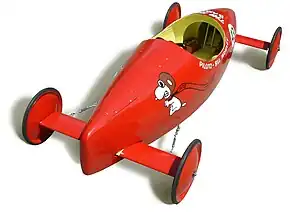
The American Soap Box Derby was inaugurated in 1934, making Montreal one of Canada's earliest entries into the sport just four years later, as well as one of the first non-US entries worldwide. Rules for the race followed those of its US counterpart, with eligibility for boys set at ages 9–15, and a car construction allowance of no more than ten dollars in its inaugural year. Like in the US, boys were expected to build their own cars with as little assistance as possible from a senior mentor. Competitors from anywhere in Canada were welcomed to attend.
A winner of the Kinsmen Coaster Classic was awarded the Henry Birks Trophy and a brand new bicycle, with a second bicycle being awarded to the runner-up. In addition to the fastest car prizes, awards were handed out for Best Looking and Best Constructed cars. Although styled like the Soap Box Derby, the race was not affiliated with nor was it a registered franchise of the American Soap Box Derby organization[lower-alpha 1] in Akron, OH, and therefore could not use their trademarked name nor refer to itself officially as the Montreal or Kinsmen 'Soap Box Derby', instead using the title 'Kinsmen Coaster Classic.' It did not send its champions to compete at the All-American World Championship in Akron.
In the seventies public interest in the Soap Box Derby began to fade, brought on by an unforeseen loss of its national sponsor and a cheating scandal that damaged its credibility as a trusted American institution. At the same time the Kinsmen Coaster Classic lost its race venue in 1973 when the street it had used for twenty years was redeveloped for construction of Montreal's Olympic Park in preparation for the 1976 Summer Olympics.
History
The Soap Box Derby began in the United States in 1934, founded by Dayton, OH native Myron Scott, a photojournalist employed by the Dayton Daily News.[2] For the first two years it hosted the All-American Soap Box Derby National Championship for boys from all across America, but in 1936 competitors from outside the US began competing as well. South Africa was the first country to send a foreign competitor,[lower-alpha 2] with Canada following suit a year later with a champ from Toronto, ON.[lower-alpha 3] Canada remained active in Soap Box Derby, having sent Champions to Akron for decades, its best showing at the All-American being Andy Vasko from St. Catharines, ON, who won third place in 1957.[6]
In 1938 the Kinsmen Club of Montreal discussed plans to conduct its own soap box race, the first one for Montreal,[7] as a means of raising charitable funds for under-privileged children in the city's poorer neighborhoods. An ophthalmological ward at a hospital was required, with the intention of offering free eye exams for the kids, and the idea was to raise funds from various groups and individuals that would be willing to sponsor contestants in the race.[8][9] Race preparations were made to help boys that needed various items like axles and wheels,[10] items they could not manufacture themselves, and a budget of no more than $10 with which to construct the car body was set, although most entrants seldom went over $1.[9]
Leading up to the first race there were as many as 400 applicants wanting to participate, but that number was paired down significantly upon inspection of the cars, most being deemed unacceptable.[11] The location of the race was kept secret until a few days before the event so that eager young lads would not venture out into traffic to test their cars. To govern against such an occurrence, organizers stipulated that if they did, they would be barred from entry.[8]
Inaugural race
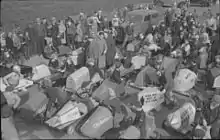
The first Kinsmen Coaster Classic was held on October 8, 1938, with fifty-six boys running as either class B (ages 9–12) or class A (ages 13–15) entries. Before a crowd of an estimated four- to five-thousand, eleven-year-old Bill Telfer, driving his stout-built "Thunderbolt," defeated class A winner Leonard Applebaum, 14, in the final, becoming the first Kinsmen Coaster Classic champion.[12] Award-winning Québécois photojournalist Conrad Poirier was present to document the event (pictured). Cars from the race were put on public display at the Eaton's Toyville on the forth floor, including Telfer's winning "Thunderbolt," and racers by Best Looking Car Award winners Hans Gruninger and Earl Mackintosh.[13] The following year the race took place in Montreal's east end under an afternoon shower, with class A entry Sydney Wright, 14, taking the top prize, and Gus Mell, 12, winning in the class B category. Bill Telfer returned in his "Thunderbolt" and was cheered on by the crowd as he clocked an excellent time while testing the track, but after the rain began his car became hampered, and he lost to Mell in the semi-final round.
Because it was also called the All Canada[14] or All-Canadian Coaster Classic in the media,[15] racers came not only from all over Montreal, but elsewhere in Quebec, British Columbia, New Brunswick, Newfoundland and Ontario.[16] From 1941 to 1943 however, it was won by just one boy, Tommy Butters from NDG in Montreal, who was also runner-up in 1940.[17] During his tenure he won in three categories; class B, class A and Ball Bearing class, and at three separate track venues. He also placed second in the Best Constructed car category the second year he was crowned champ.[18]
From the same neighborhood was Richard Powell, who made excellent showings also by winning in 1951[19] and 1953,[14] taking runner-up in his class in 1952.[20] He won soap box races in other communities as well, taking home five bicycles in the three years he competed.[21] From out of province, champs winning in 1950 and 1952 were (in order) Mervyn Roberts from Perth, ON, who won the Standard Trophy for best constructed car in 1949,[22] and Bob Jackson from Oshawa, ON. Beginning in 1954, races were being dominated by boys from the same community east of Montreal, Shawinigin-Falls, QC, having two winning streaks of three years each and one streak of two. The 1969 champion, Peter Miller, who raced the year prior but damaged his car, hailed from Montreal's West Island community of Pointe Claire, QC.[23]
Races continued annually up to the early seventies with the exception the Second World War, when they were suspended from 1944 to 1947. When the United States entered the War in 1941, the American Soap Box Derby suspended its races immediately, resuming in 1946. Not following suit, Kinsmen organizers felt that the successful fundraising benefits of the race to help Montreal's needy far outweighed the minute amount of rubber used by the boys needed for the war effort, and held off for two more years.[24] Races resumed in Montreal in 1948.
Rules

The Kinsmen Coaster Classic was ostensibly a Soap Box Derby race, just not in name, and thus followed the rules set forth by its American counterpart so that, in the event that a boy was invited to compete at the All-American, he would pass inspection and thus qualify,[11][8] In the end no champ ever attended officially.[lower-alpha 4]
One of Derby's first rules was that the car had to be boy built, without the assistance of a mentor. This was seldom the case, as most boys did require some help simply because they lacked the skills to perform such a feat, acquiring them eventually as the car was constructed while under the tutelage of an adult.[25] Sometimes a boy was asked to demonstrate knowledge of how the car was built during inspection if judges had doubts about who actually built the car.[26]
Boys raced in pairs down the hill (two lanes) in single elimination heats. Once a boy lost he was out of the race. Prior to the War, contestants were divided into two classes based on age: 9-12 raced as class B, 13-15 as class A, as stipulated by the Soap Box Derby in the US. In 1942 however, race officials redrew the distinction, this time by the kinds of wheels used, either "Ball bearing", the Official Derby wheels being used by boys in the States, or "plain bearing" or non-bearing wheels often found on wagons and baby carriages. In 1954 the classes were renamed. Although the distinction was the same, "ball bearing" became "Official wheel,"[lower-alpha 5] and "plain bearing" became "unofficial wheel." This practice continued until the end.
General restrictions concerning the car's construction included a maximum weight of 250 pounds for the car and driver together (verified during a weigh-in prior to the race), an overall length of no more than 72 inches or six feet, a wheelbase of no less than 40 inches, height not to exceed 30 inches and a wheel tread of between 30 and 36 inches. The front axle was mounted on a single kingpin, and directional control governed by steel cables, a single steering column and wheel. No ropes were allowed. The brake was to be a friction or drag type, usually an armature through the floor that was activated by a foot pedal. Wheels were to be the solid rubber type, not pneumatic, and measure no more than 12 inches. Finally the driver was to be seated upright, though the practice was to crouch forward to minimize wind resistance. Pre-race inspections verified that the car was well constructed according to strict observance of the rules, and safe to drive.[11]
Mishaps
In spite of strict regulations ensuring safety for the boys, mishaps did occur.[27] In the media at least one occurrence of a crash or crack-up was reported per race, sometimes even about a boy requiring a trip to the hospital. In 1939 for example, both champion Sydney Wright and runner-up Gus Mell experienced crack-ups on their way to their individual victories, with Wright suffering damage but quickly repairing his car before the next heat.[28] In 1960 Don Norberg of Pointe Claire, QC was injured slightly and taken to Maisonneuve Hospital after his car rolled over when struck by another vehicle.[29]
Venues
_and_Maurice_Richard_Arena_in_1969.jpg.webp)
Locations for the Kinsmen Coaster Classic, which ran on city streets, varied across five separate venues during its lifetime. The inaugural race in 1938 took place on Van Horne Avenue[lower-alpha 6] between Victoria Avenue and Van Horne Park, chosen because it was well paved and free of houses along both sides of that corridor, allowing traffic to be closed off and spectators to gather safely.[31] The next two years, races took place on an 1,100 foot track on Aird Avenue[lower-alpha 7][28] in Montreal's east end neighborhood of Maisonneuve (pictured), between Sherbrooke St. E. and Boyce Street (now Pierre-de Coubertin Ave). Today the site is occupied by Montreal's Olympic Statium, constructed in 1976. Aird was in a less developed neighborhood at the time with little traffic, ideal for races. In 1941 it moved back to Van Horne Avenue for one more year, then to the Trenholme Park neighborhood in the west Montreal neighborhood of NDG, remaining for two. Featuring a high starting ramp next to the park,[lower-alpha 8][18] the cars headed southbound on Park Row East Road down a 600-foot course[32] situated between Sherbrooke St. W and de Maisonneuve Blvd.
After cessation of hostilities in WWII the Kinsmen Coaster Classic resumed races in 1948, this time on picturesque Duluth Avenue West[lower-alpha 9] by Fletcher's Field between Park Avenue and Esplanade Avenue. Measuring approximately 525 feet in length, it was the shortest of the five venues, requiring a starting ramp that stood ten feet in height.,[22] and was used until 1950.
A permanent home
In 1951 a venue was selected on Desjardins Avenue,[lower-alpha 10] again in Montreal's east end neighborhood of Maisonneuve, nearby its Aird Avenue location eleven years earlier.[33] Like Aird it was a quiet thoroughfare ideal for running races, measuring 865 feet in length,[lower-alpha 11] with cars starting on a ramp at the top of the hill and crossing the finish 750 feet below where they were met by bales of hay if they could not stop in time.[34] This was the Classic's last venue, becoming a permanent home for over twenty years.
The end
In 1973, construction began on Montreal's Olympic Park in preparation for the 1976 Summer Olympics, with the portion of Desjardins Avenue used for the race, between Sherbrooke St. E. and Boyce St.,[33] being redeveloped to accommodate the International Plaza, Pie-IX Station for Montreal's Metro subway, and underground parking accessed from Pie-IX Boulevard.[35]
Races
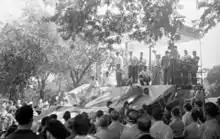
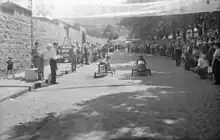


The table below lists the Kinsmen Coaster Classic race year, names of the champions and runners-up, their ages, hometown of champion, specific date when the race took place, number of entries that day, the race venue, and track length.
| Year | Champion's name | Age | Hometown | Car class | Runner-up's name | Age | Car class | Date of race | Cars entered | Venue, neighborhood | Track length |
|---|---|---|---|---|---|---|---|---|---|---|---|
| 1970 | Desjardins Ave., Maisonneuve[33] | 700–800 feet | |||||||||
| 1969 | Peter Miller[23] (pictured) | Pointe Claire, QC | Official wheel | 27 Sep[36] | Desjardins Ave., Maisonneuve[36] | 700–800 feet | |||||
| 1968 | Desjardins Ave., Maisonneuve | 700–800 feet | |||||||||
| 1967 | Desjardins Ave., Maisonneuve | 700–800 feet | |||||||||
| 1966 | Desjardins Ave., Maisonneuve | 700–800 feet | |||||||||
| 1965 | Desjardins Ave., Maisonneuve | 700–800 feet | |||||||||
| 1964 | Desjardins Ave., Maisonneuve | 700–800 feet | |||||||||
| 1963 | Alan Kitchen[37] | 14 | Shawinigin-Falls, QC | Official wheel | Karl Hardy[37] | 22 June | 41 | Desjardins Ave., Maisonneuve | 750 feet[lower-alpha 12] | ||
| 1962 | Tommy Moyle[38] | Shawinigin-Falls, QC | Official wheel | Ray MacDonald[38] | 29 June | 50[38] | Desjardins Ave., Maisonneuve | 700–800 feet | |||
| 1961 | Desjardins Ave., Maisonneuve | 700–800 feet | |||||||||
| 1960 | Johnny Macmoyle[39] | 12 | Shawinigin-Falls, QC | Official wheel | Anthony Chase[39] | 14 | 25 June | 57 | Desjardins Ave., Maisonneuve | 730 feet[39][29] | |
| 1959 | Michael Bourassa[40] | 14 | Shawinigin-Falls, QC | Official wheel | 20 June | 30+ | Desjardins Ave., Maisonneuve | 720 feet[40] | |||
| 1958 | David Paige[41] | 14 | Shawinigin-Falls, QC | Official wheel | Andrew Burnett[41] | unofficial wheel | 21 June | 36[42] | Desjardins Ave., Maisonneuve | 750 feet[41] | |
| 1957 | Fred Crowley[43] | 13 | Montreal West, QC | Official wheel | 22 June | 39[36] | Desjardins Ave., Maisonneuve | 1,025 feet[lower-alpha 13] | |||
| 1956 | Tony Bush[45] | 13 | Shawinigin-Falls, QC | Official wheel | Larry Butter[45] | unofficial wheel | 23 June | 60 | Desjardins Ave., Maisonneuve | 700–800 feet | |
| 1955 | Norman Crutchfield[46] | 14 | Shawinigin-Falls, QC | Official wheel | Charlie Large[46] | unofficial wheel | 25 June | 56[46] | Desjardins Ave., Maisonneuve | 723 feet[46] | |
| 1954 | Gordon Paige[47] | 12 | Shawinigin-Falls, QC | Official wheel | Donald Kelly[47] | unofficial wheel | 26 June | 76[47] | Desjardins Ave., Maisonneuve | 720 feet[47] | |
| 1953 | Richard Powell[14] | 14 | NDG | Henry Kennedy[14] | 27 June | 57[14] | Desjardins Ave., Maisonneuve | 900 feet[lower-alpha 14] | |||
| 1952 | Bob Jackson[19] | 14 | Oshawa, ON | Ball bearing | Richard Powell[19] | 13 | Ball bearing | 28 June[48] | 98 | Desjardins Ave., Maisonneuve | 800 feet[34] |
| 1951 | Richard Powell[20] | 12 | NDG | Ball bearing | Simon Bush[20] | 12 | Plain bearing | 16 June | 65+ | Desjardins Ave., Maisonneuve | 700–800 feet |
| 1950 | Mervyn Roberts[22] | 15 | Perth, ON | Ball bearing | Wayne Thompson[22] | Plain bearing | 17 June | Duluth Ave. W., Fletcher's Field | 525 feet[22] | ||
| 1949 | Tommy Patwell[49] | 13 | Griffintown | Ball bearing | Francis Auclair[49] | 15 | Plain bearing | 18 June | Duluth Ave. W., Fletcher's Field | 525 feet | |
| 1948 | Franz Gruninger[50] | 14[49] | Trois-Rivières, QC | Ball bearing | Arthur de Beaumont[50] | Plain bearing | 26 June | 60[51] | Duluth Ave. W., [51] Fletcher's Field | 525 feet | |
| 1944-1947 | no races[lower-alpha 15] | ||||||||||
| 1943 | Tommy Butters[52] | 15 | Hampstead | Ball bearing | Dennis Brackley[52] | Plain bearing | 10 July | 10[lower-alpha 16][52] | Trenholme Pk., NDG in Montreal | 600 feet[32] | |
| 1942 | Tommy Butters[18] | 14 | Hampstead | class A | Monty Weedon[18] | 20 June | Trenholme Pk., NDG in Montreal[18] | 600 feet | |||
| 1941 | Tommy Butters[53] | 13 | Hampstead | class A | Robert Deslaurier[53] | class B | 20 Sept | 35[53] | Van Horne Avenue, Côte-Des-Neiges | 1,100 feet | |
| 1940 | Bill Colyer[17] | Westmount | class A | Tommy Butters[17] | 12 | class B | 22 June[54] | 100+ | Aird Avenue, Maisonneuve | 1,100 feet | |
| 1939 | Sydney Wright,[28] | 14 | Verdun | class A | Gus Mell[28] | 12 | class B | 22 Sept | 50 | Aird Avenue,[28] Maisonneuve | 1,100 feet[28] |
| 1938 | Bill Telfer,[12][31] | 11 | Hampstead | class B | Leonard Applebaum[12] | 14 | class A | 8 Oct | 56[12] | Van Horne Avenue,[31] Côte-Des-Neiges | 1,100 feet[12] |
Cars
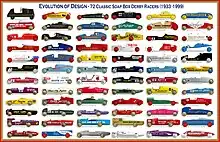
Boys that participated in the Kinsmen Coaster Class habitually gave their cars interesting names, plays on word like "Jake's Crate",[19] an assonance, "Butch's Bullet",[19] an alliteration, "Will E. Win,"[40] and "Slo-Mo-Shun."[46] Cars boasting of speed had names like "Cloud of Dust" and "Speed Demon," two cars from the 1959 race.[40] There was of course Bill Telfer's "Thunderbolt", Tony Bush's 1956 champ car "Sky Rocket,"[45] Johnny MacMoyle's 1960 champ car "Swift One,"[29] and Richard Powell's 1953 champ car "Winged Arrow," which was really about driving one's car "as straight as an arrow"[21] in order to win. Historical names included "Citation", Franz Gruninger's 1948 champ car named after the champion American Thoroughbred,[51] "Rocket Richard," after Montreal's beloved 'Rocket' Richard,[42] and "The Red Baron", of the famed WWI flying ace, on cars painted red. One car made of miscellaneous scraps of wood was called, simply enough, "Miscellaneous."[19]
The images below represent cars from both ends of the Kinsmen Coaster Classic's history, two from 1938 and two from the late sixties.
 Kinsmen Coaster Classic Champion Bill Telfer's stout-built "Thunderbolt" race car from 1938. Sponsored by Cadbury, it comprised a headrest, windscreen[lower-alpha 17] and modern wheels.
Kinsmen Coaster Classic Champion Bill Telfer's stout-built "Thunderbolt" race car from 1938. Sponsored by Cadbury, it comprised a headrest, windscreen[lower-alpha 17] and modern wheels. 1938 Kinsmen Coaster Classic Best Looking Car Award winner Hans Gruninger. Named "Condor," it featured the nascent Speedbird logo for Britain's Imperial Airways, later BOAC.
1938 Kinsmen Coaster Classic Best Looking Car Award winner Hans Gruninger. Named "Condor," it featured the nascent Speedbird logo for Britain's Imperial Airways, later BOAC.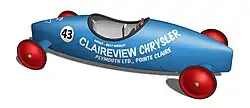 Best Constructed Trophy winner in 1968, sponsored by Claireview Chrysler of Pointe Claire, QC, painted Plymouth Blue and sporting Richard Petty's race car number 43 in the roundel
Best Constructed Trophy winner in 1968, sponsored by Claireview Chrysler of Pointe Claire, QC, painted Plymouth Blue and sporting Richard Petty's race car number 43 in the roundel A new-generation lay-down racer piloted by Peter Miller, who won the 1969 championship. The best cars that race today in the Soap Box Derby are lay-downs.
A new-generation lay-down racer piloted by Peter Miller, who won the 1969 championship. The best cars that race today in the Soap Box Derby are lay-downs.
Notes, citations and sources
Notes
- An international, largely volunteer-based event,[1] the sport is overseen by the All-American Soap Box Derby (AASBD) organization, comprising a paid administrative staff based at Derby Downs in Akron, OH[2]
- Norman Neumann of Pretoria[3][4] won the South African Championship
- George Wilson of Toronto was the first Canadian representative to race at the All-American. He did not make it past the semi-final round of the International race.[5]
- No boy from the Kinsmen Coaster Classic appears in any of the Official Race Programs of All-American Championship from 1938 to 1972
- A Soap Box Derby distinction. Official is capitalized to indicate the Official Soap Box Derby Wheel, the only issue allowed at sanctioned races in the US and Canada.
- 1st venue 45°29′38″N 73°38′17″W
- 2nd venue 45°33′37″N 73°33′11″W
- 3rd venue 45°27′41″N 73°37′54″W
- 4th venue 45°30′49″N 73°34′56″W
- 5th venue 45°33′19″N 73°33′13″W
- Measures out as approximately 865 feet according to Google Maps
- The Montreal Star reported a track length of 750 "yards",[37] which would be unlikely, instead of a more accurate 750 "feet."
- The Montreal Gazette reported a track length of 1,025 feet,[44] which would be unlikely since the street is only 865 feet long
- The Montreal Star reported 300 yards.[14]
- Like the Soap Box Derby in the US, which suspended its races from 1942 to 1945 during WWII, the Kinsmen Coaster Class followed suit for the same amount of time, only two years later.
- Lowest turnout at the Classic, due to the War
- Windscreens were dropped in 1948 according to Official Derby rules.[55]
Citations
- Iula & Ignizio 2011, p. 36.
- "Soap Box Derby history". "Soap Box Derby".
- "'Scottie' Father of Derby". "Akron Beacon Journal". 15 Aug 1936.
- "South African Soap Box Racer to Compete in National Event". "Scranton Republican". 16 Jul 1936.
- "Here Are Derby Contestants". "Akron Beacon Journal". 13 Aug 1937.
- "Akron Hailed at Banquet". "Akron Beacon Journal". 19 Aug 1957.
- "L’époque des courses de boîtes à savon". "Ici Radio Canada".
- "Soap-Box Derby Entrants Try Out on Secret Course". "Montreal Star". 27 Aug 1938.
- "Soap Box Derby is Planned Here To Aid Campaign for Eye Clinic". "Montreal Gazette". 24 Aug 1938.
- "Boys Make Own Cars for Soap Box Derby". "Montreal Star". 22 Aug 1938.
- "400 Now Enrolled For Soap-Box Race". "Montreal Gazette". 5 Sep 1938.
- "11-Year-Old Hampton Youth Wins First Local Soap Box Derby". "Montreal Gazette". 10 Oct 1938.
- "See the Prize Winning Car". "Montreal Star". 11 Oct 1938.
- "Missed Crown Once - Youngster Wins Classic". "Montreal Star". 27 Jun 1953.
- "116 Youngsters Tune Up 'Hot Rods'". "Montreal Gazette". 10 Jun 1952.
- "All-Canadian Coaster Classic Interest High". "Montreal Star". 14 Mar 1952.
- "Westmount Boy Wins Coaster Event". "Montreal Gazette". 24 Jun 1940.
- "Tommy Butters Beats Out Brother". "Montreal Gazette". 22 Jun 1942.
- "Schoolboy Speedster Wins Coaster Classic Cup, Twice". "Montreal Gazette". 30 Jun 1952.
- "Winning Drivers in Derby". "Montreal Gazette". 18 Jun 1951.
- "'Keep 'Er Straight,' Says Lad". "Montreal Gazette". 29 Jun 1953.
- "Everything Homemade Except Wheels". "Montreal Gazette". 19 Jun 1950.
- "Classic Soap Box Derby Racers (1933-1999)". "Sketchup 3D Warehouse".
- "Coasters Go Rolling By". "Montreal Gazette". 10 Jun 1942.
- Payne 2003, p. 33.
- Rosenthal 1980, p. 36.
- Rosenthal 1980, p. 34.
- "S. Wright, 14-year old Verdunite, Wins Soap-Box Race In Field of 50". "Montreal Gazette". 2 Oct 1939.
- "'Swift One' Swiftest in Coaster Classic". "Montreal Star". 27 Jun 1960.
- "Photo". "City of Montreal".
- "Coaster Derby Route Chosen by Kinsmen". "Montreal Star". 5 Oct 1938.
- "Kinsmen Hold Coaster Derby". "Montreal Gazette". 12 Jul 1943.
- "100 ans de sports et loisirs à Maisonneuve". "City of Montreal".
- "Oshawa Boy Takes Trophy". "Montreal Star". 28 Jun 1952.
- "1976 Olympic Park Map". "Architecture of the Games".
- "Coaster classic set for Sept. 27". "Montreal Gazette". 4 Sep 1969.
- "Shawinigan Boy Leader in Coasters". "Montreal Star". 24 Jun 1963.
- "Tommy Moyle se Signale à Montréal". "L'Echo du St-Maurice". 2 Oct 1962.
- "Kiss Tough For Winner". "Montreal Gazette". 27 Jun 1960.
- "Shawinigan Boy Takes Coaster Classic Prizes". "Montreal Star". 22 Jun 1959.
- "Shawinigan Boy Takes Coaster Classic Prizes". "Montreal Gazette". 23 Jun 1958.
- "Homemade Racing Cars 'Burn Up' Track". "Montreal Star". 25 Jun 1958.
- "He Coasted to Victory". "Montreal Star". 24 Jun 1957.
- "Montreal West Youth Wins Soapbox Race". "Montreal Gazette". 25 Jun 1957.
- "Young Shawinigan Enthusiasts Win Soap Box Racing Classic". "Montreal Gazette". 25 Jun 1956.
- "Shawinigan Boy Wins Coaster Race". "Montreal Gazette". 27 Jun 1955.
- "'Potato Bug' Paige Heads Hodge-Podge of Hot Rods". "Montreal Gazette". 26 Jun 1954.
- "Coaster Classic Set". "Montreal Star". 6 Jun 1952.
- "Annual Kinsmen Coaster Classic Won by Tommy Patwell, Griffintown". "Montreal Gazette". 20 Jun 1949.
- "Coaster Classic Champs". "Montreal Star". 28 Jun 1948.
- "Citation Beats Field of 60 Entries". "Montreal Gazette". 28 Jun 1948.
- "Tommy Butters Wins 3rd Coaster Event". "Montreal Gazette". 12 Jul 1943.
- "T. Butters Winner in Soapbox Derby". "Montreal Gazette". 22 Sep 1941.
- "More Prizes Offered". "Montreal Gazette". 13 Jun 1940.
- Iula & Ignizio 2011, p. 78.
Sources
Books
- Rosenthal, Sylvia A. (1980). Soap Box Derby Racing (1st ed.). Lorthop, Lee & Shepard Books. ISBN 978-0688519155. Retrieved 4 Sep 2023.
- Payne, Melanie (2003). Champions, Cheaters, and Childhood Dreams: Memories of the Soap Box Derby (1st ed.). University of Akron Press. ISBN 978-1935603481. LCCN 2003008689. Retrieved 4 Sep 2023.
- Iula, Jeff; Ignizio, Bill (2011). How I Saw It: My Photographic Memory of the Soap Box Derby (1st ed.). University of Akron Press. ISBN 978-1935603078. Retrieved 5 Sep 2023.
News
- "South African Soap Box Racer to Compete in National Event". Scranton Republican. 16 Jul 1936. p. 4.
- "'Scottie' Father of Derby". Akron Beacon Journal. 15 Aug 1936. p. 34.
- "Here Are Derby Contestants". Akron Beacon Journal. 13 Aug 1937. p. 14.
- "Boys Make Own Cars for Soap Box Derby". Montreal Star. 22 Aug 1938. p. 4.
- "Soap-Box Derby Entrants Try Out on Secret Course". Montreal Star. 27 Aug 1938. p. 3.
- "Soap Box Derby is Planned Here To Aid Campaign for Eye Clinic". Montreal Gazette. 24 Aug 1938. p. 4.
- "400 Now Enrolled For Soap-Box Race". Montreal Gazette. 5 Sep 1938. p. 4.
- "Coaster Derby Route Chosen by Kinsmen". Montreal Star. 5 Oct 1938. p. 3.
- "Bill Telfer, 11 Wins First Soap Box Derby". Montreal Star. 10 Oct 1938. p. 4 & 9.
- "11-Year-Old Hampton Youth Wins First Local Soap Box Derby". Montreal Gazette. 10 Oct 1938. p. 13.
- "See the Prize Winning Cars". Montreal Star. 11 Oct 1938. p. 33.
- "S. Wright, 14-year old Verdunite, Wins Soap-Box Race In Field of 50". Montreal Gazette. 2 Oct 1939. p. 13.
- "More Prizes Offered". Montreal Gazette. 13 Jun 1940. p. 9.
- "Westmount Boy Wins Coaster Event". Montreal Gazette. 24 Jun 1940. p. 11.
- "T. Butters Winner in Soapbox Derby". Montreal Gazette. 22 Sep 1941. p. 13 & 14.
- Mcheil, Marc T. (10 Jun 1942). "Coasters Go Rolling By". Montreal Gazette. p. 16.
- "Tommy Butters Beats Out Brother". Montreal Gazette. 22 Jun 1942. p. 13.
- "Kinsmen Hold Coaster Derby". Montreal Gazette. 12 Jul 1943. p. 24.
- "Tommy Butters Wins 3rd Coaster Event". Montreal Gazette. 12 Jul 1943. p. 13.
- "Citation Beats Field of 60 Entries". Montreal Gazette. 28 Jun 1948. p. 3.
- "Coaster Classic Champs". Montreal Star. 28 Jun 1948. p. 28.
- Croll, Bruce (20 Jun 1949). "Annual Kinsmen Coaster Classic Won by Tommy Patwell, Griffintown". Montreal Gazette. p. 3.
- "Everything Homemade Except Wheels". Montreal Gazette. 19 Jun 1950. p. 15.
- "Winning Drivers in Derby". Montreal Gazette. 18 Jun 1951. p. 15.
- "All-Canadian Coaster Classic Interest High". Montreal Star. 14 Mar 1952. p. 18.
- "Coaster Classic Set". Montreal Star. 6 Jun 1952. p. 18.
- "116 Youngsters Tune Up 'Hot Rods'". Montreal Gazette. 10 Jun 1952. p. 33.
- "Schoolboy Speedster Wins Coaster Classic Cup, Twice". Montreal Gazette. 30 Jun 1952. p. 13.
- "Oshawa Boy Takes Trophy". Montreal Star. 28 Jun 1952. p. 3.
- "Missed Crown Once - Youngster Wins Classic". Montreal Star. 27 Jun 1953. p. 3.
- "'Keep 'Er Straight,' Says Lad". Montreal Gazette. 29 Jun 1953. p. 3.
- "'Potato Bug' Paige Heads Hodge-Podge of Hot Rods". Montreal Gazette. 28 Jun 1954. p. 12.
- "Shawinigan Boy Wins Coaster Race". Montreal Gazette. 27 Jun 1955. p. 35.
- "Young Shawinigan Enthusiasts Win Soap Box Racing Classic". Montreal Gazette. 25 Jun 1956. p. 3.
- "He Coasted to Victory". Montreal Star. 24 Jun 1957. p. 2.
- "Montreal West Youth Wins Soapbox Race". Montreal Gazette. 25 Jun 1957. p. 4.
- "Akron Hailed at Banquet". Akron Beacon Journal. 19 Aug 1957. p. 19.
- "Homemade Racing Cars 'Burn Up' Track". Montreal Star. 25 Jun 1958. p. 4.
- "Shawinigan Boy Wins Soap Box Race Classic". Montreal Gazette. 23 Jun 1958. p. 3.
- "Shawinigan Boy Takes Coaster Classic Prizes". Montreal Star. 22 Jun 1959. p. 3.
- "Kiss Tough For Winner". Montreal Gazette. 27 Jun 1960. p. 9.
- "'Swift One' Swiftest in Coaster Classic". Montreal Star. 27 Jun 1960. p. 2.
- "Tommy Moyle se Signale à Montréal". L'Echo du St-Maurice. 2 Oct 1962. p. 12.
- "Shawinigan Boy Leader in Coasters". Montreal Star. 24 Jun 1963. p. 21.
- "Coaster classic set for Sept. 27". Montreal Gazette. 4 Sep 1969. p. 46.
Websites
- "Photo". City of Montreal. Retrieved 4 Sep 2023.
- "Soap Box Derby history". Soap Box Derby. Retrieved 4 Sep 2023.
- "1976 Olympic Park Map". Architecture of the Games. Retrieved 31 August 2023.
- "L'époque des courses de boîtes à savon". Ici Radio Canada. Retrieved 31 August 2023.
- Bouchard-Dupont, Maude. "100 ans de sports et loisirs à Maisonneuve". City of Montreal. Retrieved 2 Sep 2023.
- "Classic Soap Box Derby Racers (1933-1999)". Sketchup 3D Warehouse. Retrieved 31 August 2023.